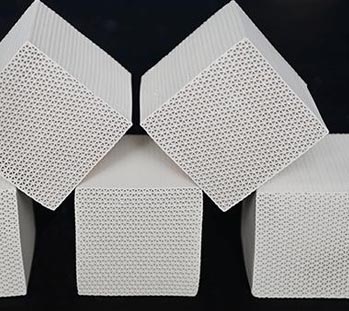
Zeolite is a porous aluminosilicate crystal (a1uminsi1ict) with a water bearing frame structure, which exists naturally in nature and is also artificially synthesized. The ideal chemical formula of zeolite can be expressed as Mx/yA1XSiyO2 (x y) P? H2O, where M is alkali metal (such as Na, K, Li) and alkaline earth metal (such as Ca, Mg, Ba, Sr). The chemical composition of zeolite is generally considered to be composed of A12O3, SiO2, H2O and metal cations, of which A12O3 and SiO2 account for about 80% of the total zeolite minerals. In different zeolite minerals, the proportion of silicon and aluminum is different, and the different proportion will cause some characteristics of zeolite changes, such as ion exchange and acid resistance.
Because the silicon (aluminum) oxygen tetrahedron of natural zeolite crystal has many holes and channels, which occupy cations and water molecules. When some other goods are completely dehydrated after baking, the crystal skeleton is not damaged, but forms large holes on the inner surface, which can absorb and store a large number of molecules, so it has the characteristics of large adsorption capacity and high selectivity.
(1) There are cavities and channels in the crystal structure of zeolite with large adsorption capacity, whose volume accounts for more than 50% of the total volume of zeolite crystals. Moreover, the micropores of zeolite are evenly distributed, and the pore size is small, which is equivalent to the molecular size of general substances. The internal surface area of zeolite crystals can reach more than 1000 square meters. Therefore, the adsorption capacity of zeolite is particularly large.
(2) The holes and channels inside the highly selective zeolite crystal are uniform and fixed in size, and the diameter of the holes is generally 6~15A. Only molecules with smaller diameter can enter the cavity through the zeolite channel and be adsorbed, while large molecules cannot enter the cavity and be adsorbed. Zeolite is also called molecular sieve because of its selective adsorption performance. And silica gel Activated carbon Such adsorbents have no selective adsorption and screening performance due to no uniform fixed pore size and large variation. Price of Shunyi zeolite filter material
(3) The highly effective selective adsorption is due to the fact that the alumina tetrahedron of zeolite has a negative charge, while the skeleton hole contains cations, which forms a strong electric field around the cations. Therefore, the adsorption force of zeolite not only has a strong dispersion force, but also has a large electrostatic force. It is precisely because of this electrostatic relationship that zeolites have preferential selective adsorption on polar, unsaturated and polarizable molecules. It can strongly adsorb molecules containing polar groups such as hydroxyl ion, ammonium ion and other polarizable groups, especially water, which can form hydrogen bonds with aluminum silicon skeleton, so zeolite has strong water absorption. It can still adsorb even under low relative humidity and concentration, and its water absorption is higher than that of silica gel and activated alumina.
The adsorption capacity of zeolite for organic pollutants mainly depends on the polar size and molecular diameter of organic molecules. Small molecules are easier to be adsorbed than large molecules, while polar molecules are easier to be adsorbed than non-polar ones. Due to the existence of different substances in water (such as organic molecules, metal ions and water molecules), their polarity and molecular size are different, and competition will occur during adsorption.
